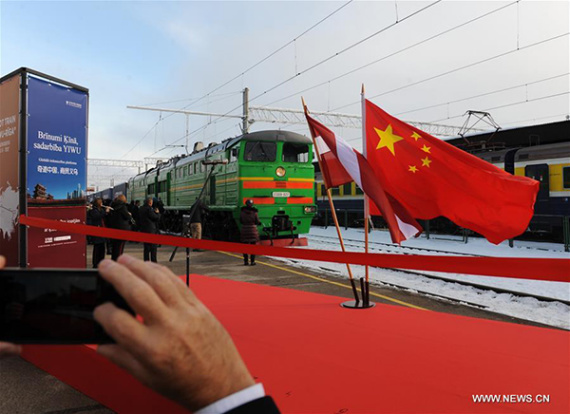 |
 |
 |
 |
 |
 |
 |
 |
 |
 |
 The freight train from Yiwu of China to Riga enters the Central Station of Riga, Latvia, Nov 5, 2016. The first trans-Eurasia container train linking China and Latvia arrived here on Saturday afternoon, marking a milestone in the history of the two countries' cooperation in transport and logistics sectors.(Photo/Xinhua) The "eyeball-to-eyeball standoff" between Chinese and Indian troops high in the Himalayas is the longest yet. Usually border incursions are sorted out within days, but this one has been going on for more than a month with no sign of it ending. Whereas the vast majority of frictions at the Line of Actual Control occur in the disputed western and eastern sectors of the border, the current standoff has unfolded after Indian troops crossed the demarcated and mutually recognized Sikkim section of the border into Chinese territory. The Indian troops incursion into Doklam was to obstruct China's construction of a road. In fact, over the past years there has been a lot of criticism in India about China's road and railway construction in the Tibet autonomous region. Which begs the question, why is India so sensitive about China's infrastructure construction. The answer to that question is a reflection of India's resistance to opening up, as well as its arrogance and sense of exclusiveness. The Indian government describes China's road construction as a "significant change of the status quo with serious security implications for India", highlighting the geographic proximity of the road to its vulnerable "Chicken's Neck"-the narrow stretch of territory connecting the majority of India to its more remote northeast areas. However, the road being constructed is in Chinese territory. Frankly speaking, even if India is concerned, it doesn't have the right to interfere, let alone make an incursion. Obviously the trespassing by Indian troops violates China's sovereignty. What's more, India pursues a double standard in this regard. Recently India has been desperately trying to complete its India-China Border Roads Project, which envisages the construction of 73 strategic roads along the Line of Actual Control, of which 27 roads are currently operational. In May, Indian Prime Minister Narendra Modi chose to commemorate three years of his administration by opening a bridge, the country's longest, over the Lohit River, which will significantly reduce the travel time to the disputed eastern territory. And in terms of military deployment along the Line of Actual Control, India has an evident advantage over China. There are nine Indian mountain divisions under the III, IV, and XXXIII Corps of its Eastern Command, which are all oriented to the north. To support these divisions, the Indian Army has also built numerous logistics nodes, troop habitats and underground storage facilities. Moreover, the Indian Army has created the XVII Mountain Strike Corps under its Eastern Command so it can conduct quick offensives or counter-offensives. The Indian Air Force also enjoys an advantage, with its 22 airfields in the eastern sector located much closer to the Line of Actual Control. Its fighters and bombers, with their bases in the plains, will be able to take off without any payload penalties and will require considerably less fuel to reach their targets. With the above superior military deployment, it is quite ridiculous for India to view itself as the weaker party and for it to take China's road construction in Doklam as a threat. Its actions can only be explained as either the pursuit of regional hegemony or a manifestation of an inferiority complex, in which it is trying to hide its weakness by taking strong actions. Roads can be the path to wealth or the way to war. In China there is a saying "build roads before building wealth" and road construction has played an important role in the country's rapid development, not only bringing wealth to China, but also paving the way for cooperation between China and its neighbors. Unfortunately, India views infrastructure in the border areas as only for military use with little consideration for their valuable role in economic development. In fact, the trespass incident in Doklam has forced China to close the Nathu La border crossing, stopping Indian religious pilgrims from visiting Lake Manasarovar in Tibet, which is sacred to both Hindus and Buddhists, hurting Sikkim's tourism industry, which accounts for 65 percent of the state's GDP. India pursued a strategy of deliberate neglect toward its border areas in the decades following the Sino-Indian border war in 1962, convinced that a scarcity of infrastructure would hamper any invasion from the north. It is only in recent years that New Delhi has acknowledged the futility of that strategy and ordered massive border infrastructure upgrades. Yet in recent years, the infrastructure connectivity in Eurasia has been enhanced, especially with the rolling out of China's Belt and Road Initiative, which, since it highlights mutual benefit and common development, has been warmly welcomed by an overwhelming majority of the countries in the world. India is one of the few exceptions. Unlike other South Asian countries, India is opposed to the initiative as it considers it an attempt by China to circumvent it. In the view of India, with the development of new infrastructure connecting China and South Asian countries, trade, investment, industrial zones, and all sorts of services, will follow in the wake of newly constructed railways, roads and ports. Therefore, it fears South Asia will be drawn into the orbit of China's powerful economy, and political leverage will follow. Although the Belt and Road Initiative has been proposed by China, it is also in the interests of others, since it embodies the spirit of peace and cooperation, openness and inclusiveness, mutual learning and mutual benefit. But whether India regards it as an opportunity depends on its politicians demonstrating wisdom and judgment. China and India enjoy many similarities, but they are also engaged in competition. India's attitude toward China's road construction in the age of globalization is a mirror, reflecting its lack of vision, closed mind and intolerance. It reflects not only the gap that exists between the two Asian giants in terms of their GDPs, but also the wide gaps in confidence, openness and inclusiveness. China is developing in the 21st century whereas India remains in the 19th century. Its backward strategy is a historical mistake. The author Zhao Xiaozhuo is a senior colonel and senior fellow at the Academy of Military Sciences of the People's Liberation Army. |
Powered by Discuz! X3.4
© 2001-2013 Comsenz Inc.